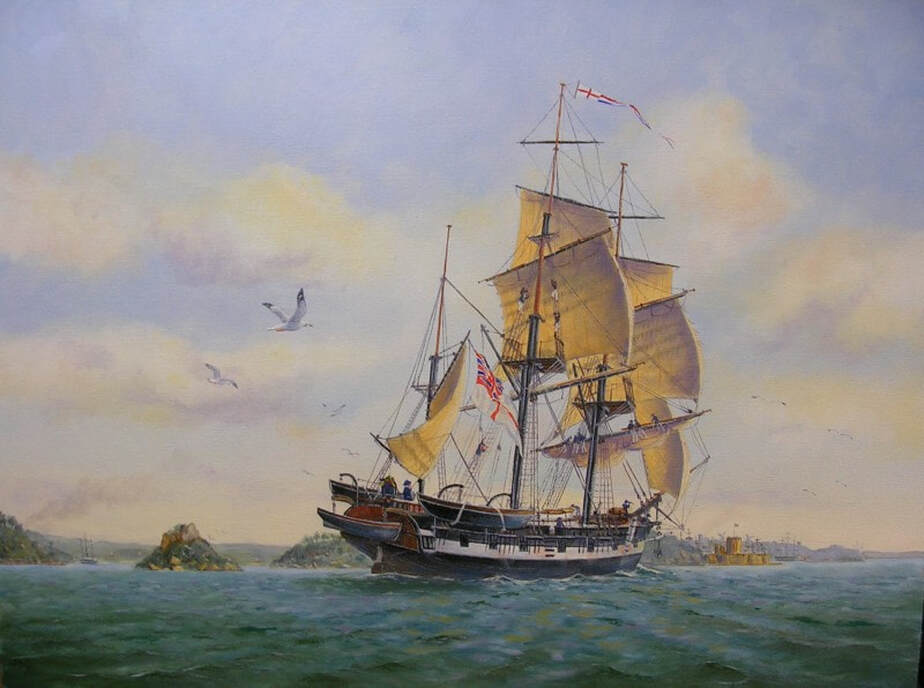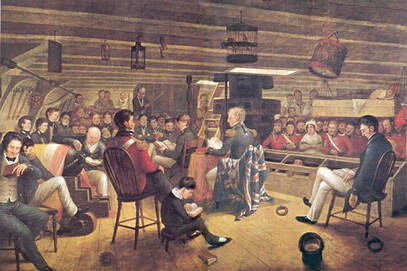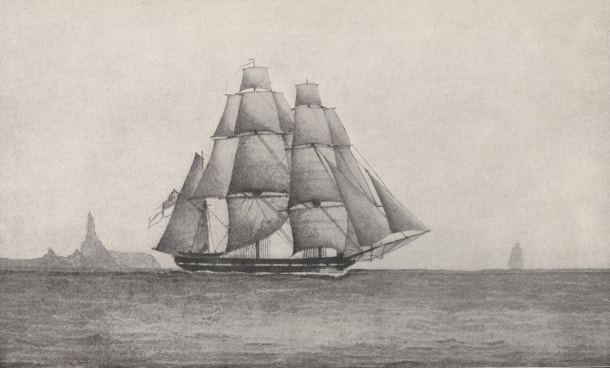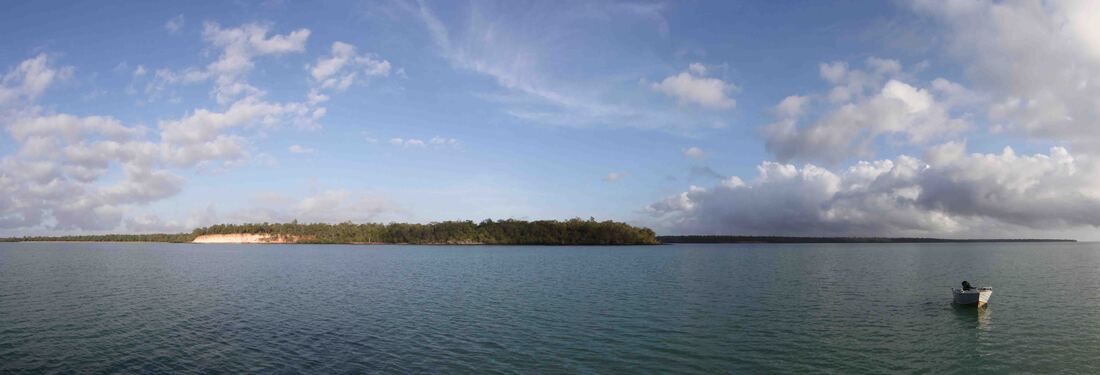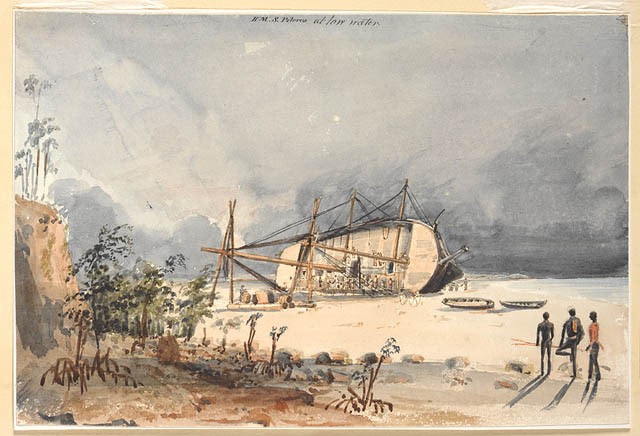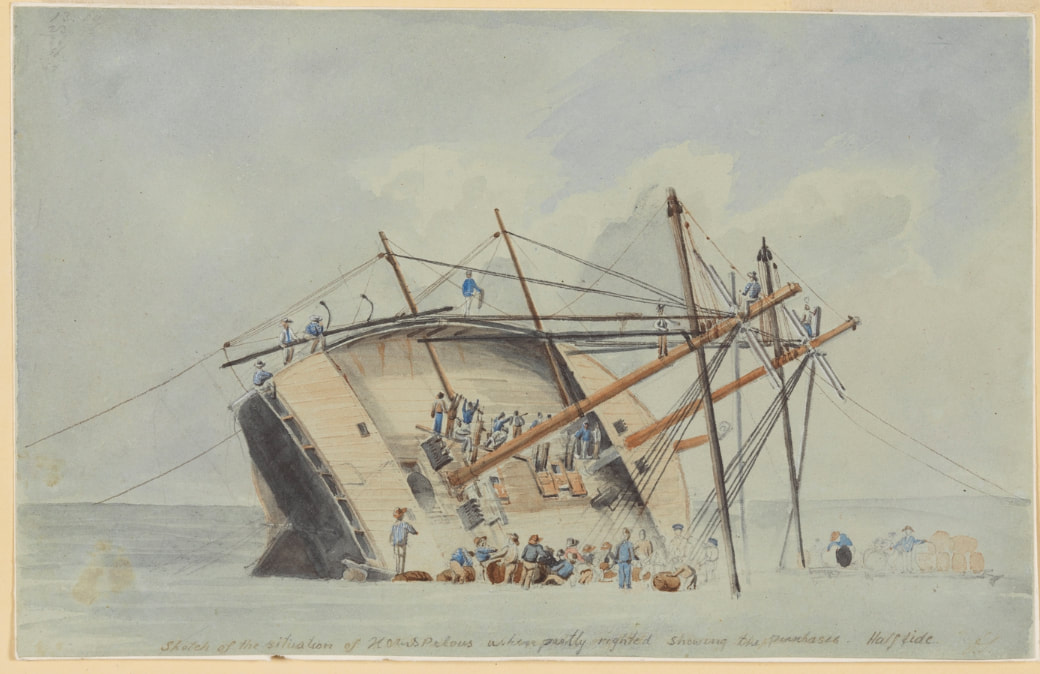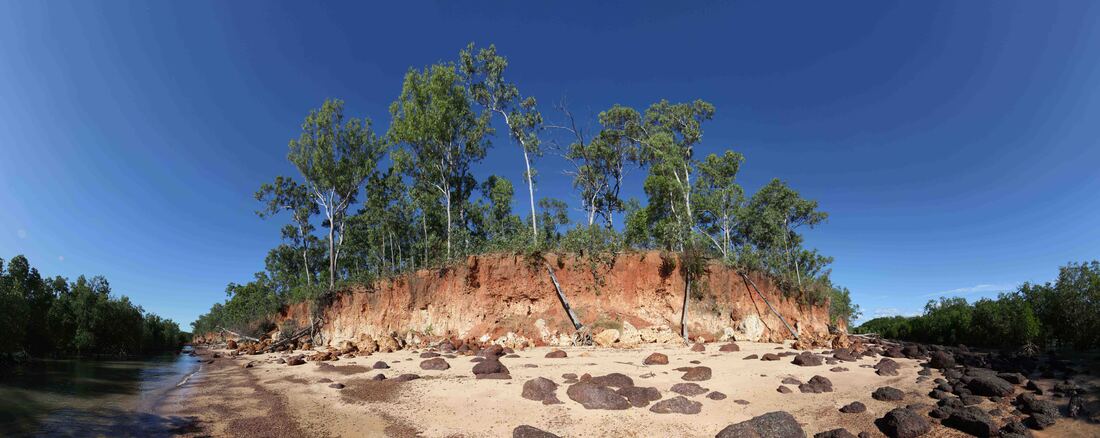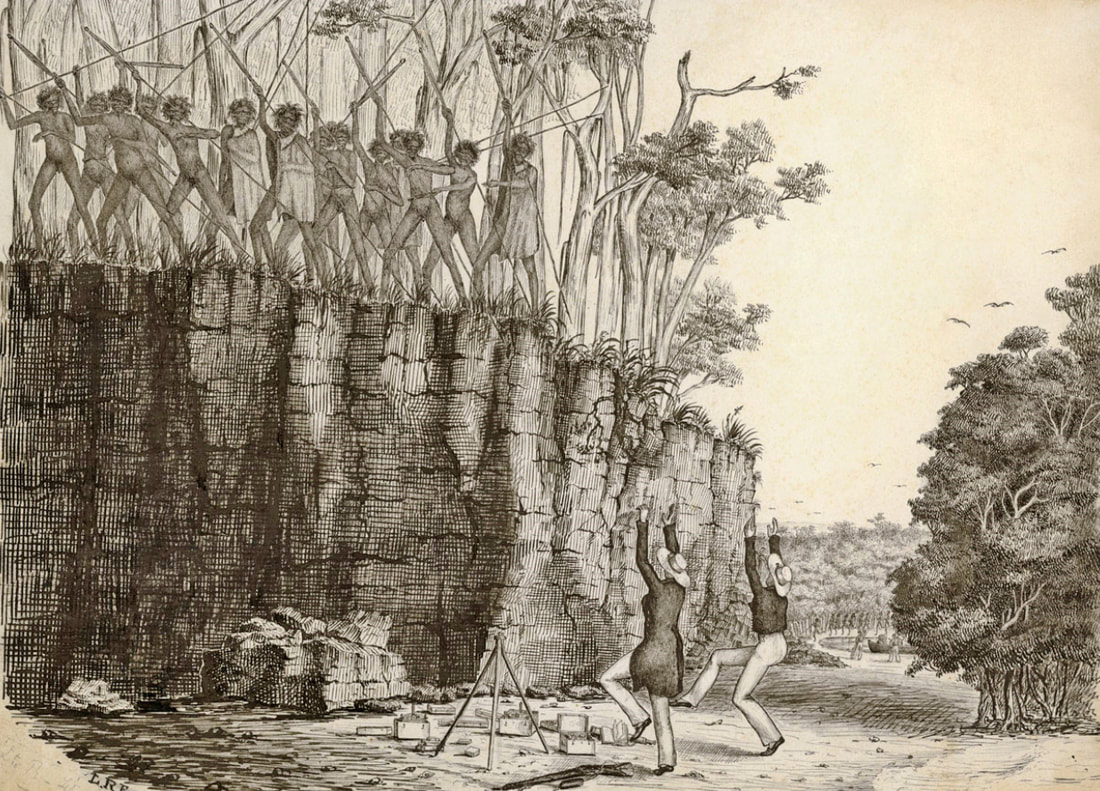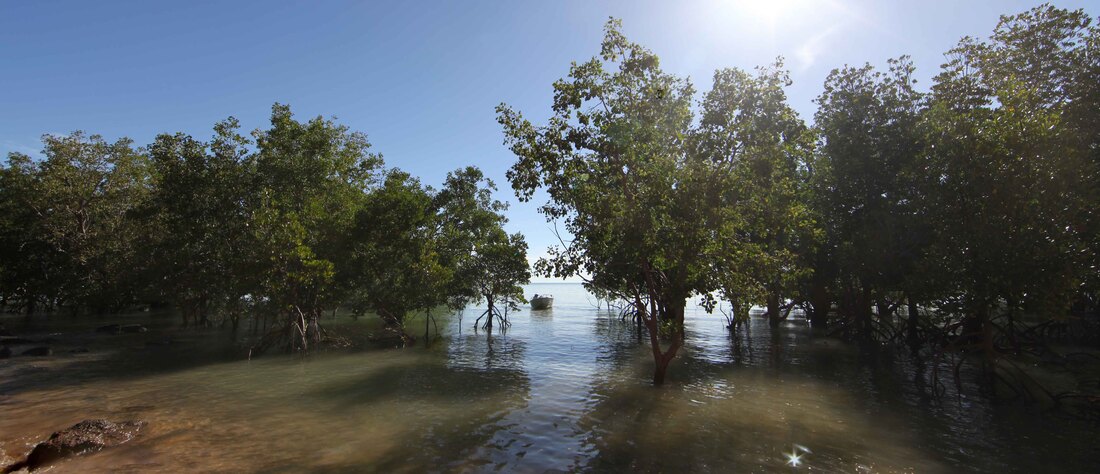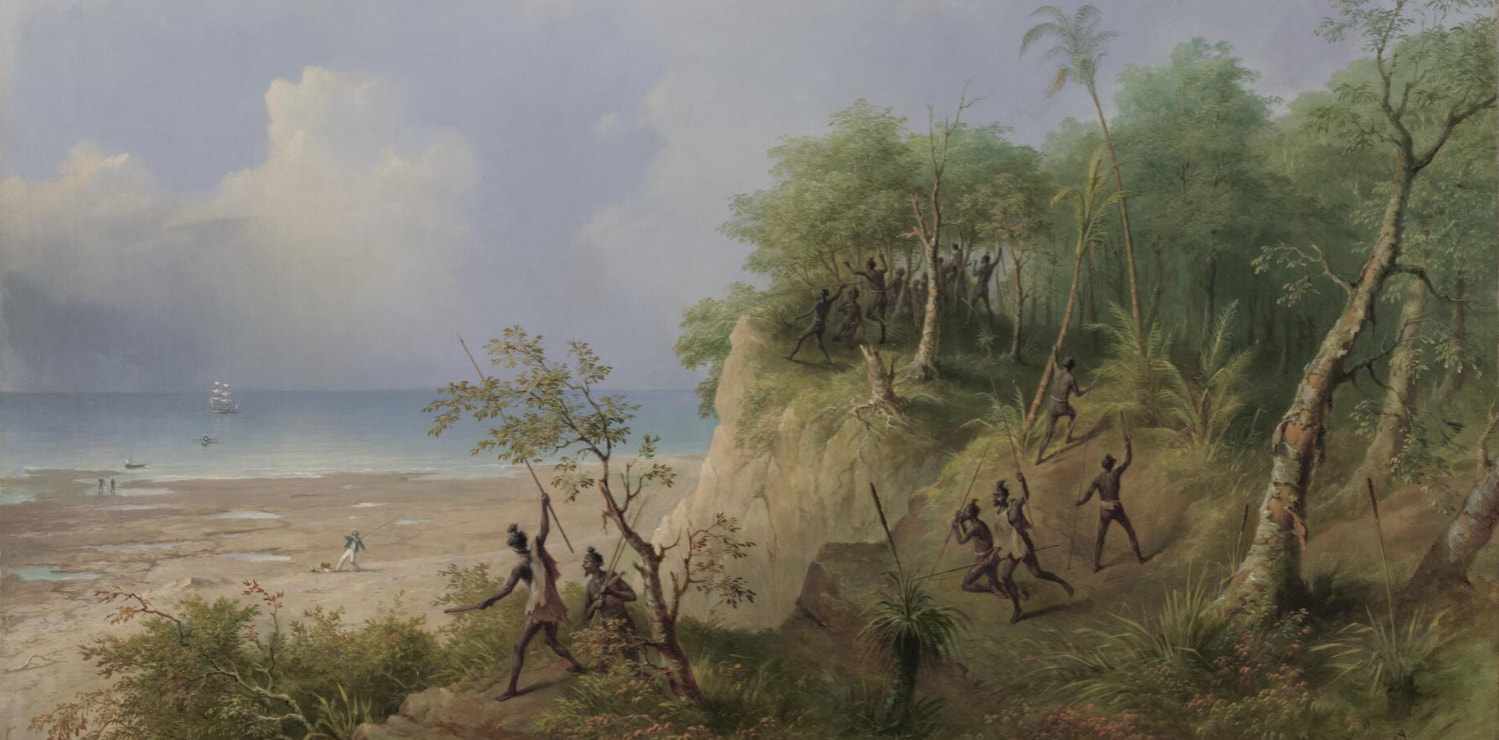Her Majesty's Survey Ship Beagle in NT Waters
Basic Configuration
|
Designed - 1807 - Sir Henry Peake - surveyor of the Navy {1806-23}
Roles - Coastal Defence - anti-piracy/smuggling - survey - intelligence gathering and communications. Brig Sloop Armour - 10 gun {8 short carronades - 2 long six pounders} - 6 guns as a survey vessel. Class - Cherokee, {first five 10 gun brigs were Achates, Parthian, Cherokee Cadmus & Rolla} Beagle being No. 41 (45) of >107 - (Ref. Keith Thompson) Keel laid - June 1818 - Woolwich |
Launched - 11 May 1820
Length - 90ft Beam - 24.5ft Draught - 12ft Height - 112ft {waterline to main-mast truck} Tonnage - 235 ton burthen Cost - £7,803 |
The above figures refer basically to her status for the First Voyage 1826-1830 to South America being basicaly that of a Cherokee Class 10 gun brig with less guns and some deckhousing. FitzRoy supervised and personally funded a major refit for the Second Voyage 1831-1832 to South America that almost equalled her original cost - see K. Thomson below. However, there appears to have been no substantial alterations made prior to the Third Voyage to survey the Australian coast between 1837 & 1843.
Port Essington
HMS Pelorus
Paintings of HMS Pelorus by Capt. Owen Stanley - she was grounded during the cyclone of 1839 that spun the Beagle around in the mouth of the Victoria River - fouling her anchors and causing great alarm. The technique for refloating using her own spars & rigging was entirely successful.
Escape Cliffs - Adelaide River
Many of the crew from that voyage (Wickham, Stokes, Fitzmaurice & Forsyth) were still with the Beagle for the Third Voyage which furnished Admiralty Charts of much of the Australian coast and made discoveries including Port Darwin - the Fitzroy, Adelaide, Victoria and Fitzmaurice Rivers - the charting of Bass Strait, the north coast of Tasmania and the southern coast of Victoria together with the entrance and significant areas of Port Phillip Bay. Charles Darwin had been with the Beagle surveying southern Australia but was no longer among the ship's company when, on 27th July 1839, Commander Wickham anchored her in a broad bay off Clarence Strait - which he named Adam Bay - at once dispersing his men to search for a great river to carry exploration into the dark interior which would not be crossed until John McDouall Stuart reached the north coast at Chambers Bay on 24th July 1862.
"Impatient to learn the truth, Mr. Fitzmaurice was despatched to examine the head of the bay, whilst the ship was moved towards it, anchoring again one mile North-West from a very remarkable patch of low red cliffs (which from startling circumstances, hereafter to be related, were called Escape Cliffs)……On returning to the ship we found that Mr. Fitzmaurice had arrived, bringing the expected, and very gratifying intelligence, that a large river with two branches, running South-East and South, with a depth of four fathoms, emptied itself into the head of the bay."
They had discovered the Adelaide River which they named for the Queen Dowager and Adam Bay for Vice-Admiral Sir Charles Adam. It was to become the site of South Australia’s first attempt at a Northern Capital for its Northern Territory and would be called Palmerston - the original name for Darwin City & today the name of her satellite city. Sagas of triumph & disaster - not without their lighter moments. On 9 September 1839 the Beagle sailed into Darwin harbour - it was named by John Clements Wickham & John Lort Stokes for their former shipmate whose 'geologising' resonated in their memories.
"Impatient to learn the truth, Mr. Fitzmaurice was despatched to examine the head of the bay, whilst the ship was moved towards it, anchoring again one mile North-West from a very remarkable patch of low red cliffs (which from startling circumstances, hereafter to be related, were called Escape Cliffs)……On returning to the ship we found that Mr. Fitzmaurice had arrived, bringing the expected, and very gratifying intelligence, that a large river with two branches, running South-East and South, with a depth of four fathoms, emptied itself into the head of the bay."
They had discovered the Adelaide River which they named for the Queen Dowager and Adam Bay for Vice-Admiral Sir Charles Adam. It was to become the site of South Australia’s first attempt at a Northern Capital for its Northern Territory and would be called Palmerston - the original name for Darwin City & today the name of her satellite city. Sagas of triumph & disaster - not without their lighter moments. On 9 September 1839 the Beagle sailed into Darwin harbour - it was named by John Clements Wickham & John Lort Stokes for their former shipmate whose 'geologising' resonated in their memories.
A few days after my interview with the natives, 'Mr. Fitzmaurice went ashore to compare the compasses. From the quantity of iron contained in the rocks, it was necessary to select a spot free from their influence. A sandy beach at the foot of Escape Cliffs was accordingly chosen. The observations had been commenced, and were about half completed, when on the summit of the cliffs, which rose about twenty feet above their heads, suddenly appeared a large party of natives with poised and quivering spears, as if about immediately to deliver them. Stamping on the ground, and shaking their heads to and fro, they threw out their long shaggy locks in a circle, whilst their glaring eyes flashed with fury as they champed and spit out the ends of their long beards.* (*Footnote. A custom with Australian natives when in a state of violent excitement.) They were evidently in earnest, and bent on mischief.
It was, not a little surprising to behold this paroxysm of rage evaporate before the happy presence of mind displayed by Mr. Fitzmaurice, in immediately beginning to dance & shout, though in momentary expectation of being pierced by a dozen spears. In this he was imitated by Mr. Keys, who was assisting in the observations, & who at the moment was a little distance off & might have escaped. Without, however, thinking of himself, he very nobly joined his companion in amusing the natives; and they succeeded in diverting them from their evident evil designs, until a boat landing in a bay near drew off their attention.'
'Messrs. Fitzmaurice and Keys had firearms lying on the ground within reach of their hands; the instant, however, they ceased dancing, an attempted to touch them, a dozen spears were pointed at their breasts. Their lives hung upon a thread, and their escape must be regarded as truly wonderful, and only to be attributed to the happy readiness with which they adapted themselves to the perils of their situation. This was the last we saw of the natives in Adam Bay, and the meeting is likely to be long remembered by some, and not without pleasant recollections; for although, at the time, it was justly looked upon as a very serious affair, it afterwards proved a great source of mirth'. (John Lort Stokes, Discoveries in Australia) The sketch above is by Lewis Roper Fitzmaurice after whom the Fitzmaurice River near the NT/WA border is named. The Roper River is named for one of Leichhardt's party.
It was, not a little surprising to behold this paroxysm of rage evaporate before the happy presence of mind displayed by Mr. Fitzmaurice, in immediately beginning to dance & shout, though in momentary expectation of being pierced by a dozen spears. In this he was imitated by Mr. Keys, who was assisting in the observations, & who at the moment was a little distance off & might have escaped. Without, however, thinking of himself, he very nobly joined his companion in amusing the natives; and they succeeded in diverting them from their evident evil designs, until a boat landing in a bay near drew off their attention.'
'Messrs. Fitzmaurice and Keys had firearms lying on the ground within reach of their hands; the instant, however, they ceased dancing, an attempted to touch them, a dozen spears were pointed at their breasts. Their lives hung upon a thread, and their escape must be regarded as truly wonderful, and only to be attributed to the happy readiness with which they adapted themselves to the perils of their situation. This was the last we saw of the natives in Adam Bay, and the meeting is likely to be long remembered by some, and not without pleasant recollections; for although, at the time, it was justly looked upon as a very serious affair, it afterwards proved a great source of mirth'. (John Lort Stokes, Discoveries in Australia) The sketch above is by Lewis Roper Fitzmaurice after whom the Fitzmaurice River near the NT/WA border is named. The Roper River is named for one of Leichhardt's party.
Port Darwin
Victoria River
VISIT THE SHORE FOR OBSERVATIONS.
December 7.
"I left the ship in the morning to make some observations at Point Pearce for the errors of the chronometers. I was accompanied to the shore by Mr. Bynoe, who was going on a shooting excursion. It being high-water, I was obliged to select a spot near the cliffs forming the point, for carrying out my intention. That selected was about 60 yards from the wood-crowned cliff which rose behind; thinking such an intervening distance would secure me from the spear of the treacherous native. This caution rather resulted from what had before occurred at Escape Cliffs, where Messrs. Fitzmaurice and Keys so narrowly escaped, than from any idea that natives might be lurking about. Indeed, Mr. Bynoe had been shooting all over the ground yesterday, and had neither seen nor heard anything to indicate their existence in this neighbourhood; though doubtless, from what followed, they had been very busily watching him all the time, and were probably only deterred from making an attack, by the alarm with which his destructive gun, dealing death to the birds, must have filled them. Requiring equal altitudes, I was compelled to revisit the spot in the afternoon for the corresponding observations. The boat in which Mr. Bynoe returned to the ship, was to carry me on shore. We met at the gangway, and in answer to my inquiry, he informed me that he had seen no traces of the natives. He had shot a new and very beautiful bird of the finch tribe, in which the brilliant colours of verdigris green, lilac purple, and bright yellow, were admirably blended.* The time was short; half an hour would have sufficed for the observations, and we should have left the coast. As it was now low-water, and I had to traverse a coral reef half a mile in width, I resolved to lighten myself of my gun, which I had taken with me in the morning, that I might with greater safety carry the chronometer. On landing I directed Mr. Tarrant and one of the boat's crew to follow with the rest of the instruments. The walking was very bad, the reef being strewed with coral fragments, and interspersed with large pools. With my mind fully occupied by all we had seen of late, I hurried on without waiting, and reached the observation spot, just glancing towards the cliff, which presented nothing to the view except the silvery stems of the never-failing gumtrees.
(*Footnote. Figured by Mr. Gould from this specimen as Amadina gouldiae.)
THE AUTHOR SPEARED.
I had just turned my head round to look after my followers when I was suddenly staggered by a violent and piercing blow about the left shoulder:* and ere the dart had ceased to quiver in its destined mark, a loud long yell, such as the savage only can produce, told me by whom I had been speared.
(*Footnote. See the view annexed. ) CAPTAIN STOKES SPEARED AT POINT PEARCE. C. Martens, del. London, Published by T. & W. Boone, 1
December 7.
"I left the ship in the morning to make some observations at Point Pearce for the errors of the chronometers. I was accompanied to the shore by Mr. Bynoe, who was going on a shooting excursion. It being high-water, I was obliged to select a spot near the cliffs forming the point, for carrying out my intention. That selected was about 60 yards from the wood-crowned cliff which rose behind; thinking such an intervening distance would secure me from the spear of the treacherous native. This caution rather resulted from what had before occurred at Escape Cliffs, where Messrs. Fitzmaurice and Keys so narrowly escaped, than from any idea that natives might be lurking about. Indeed, Mr. Bynoe had been shooting all over the ground yesterday, and had neither seen nor heard anything to indicate their existence in this neighbourhood; though doubtless, from what followed, they had been very busily watching him all the time, and were probably only deterred from making an attack, by the alarm with which his destructive gun, dealing death to the birds, must have filled them. Requiring equal altitudes, I was compelled to revisit the spot in the afternoon for the corresponding observations. The boat in which Mr. Bynoe returned to the ship, was to carry me on shore. We met at the gangway, and in answer to my inquiry, he informed me that he had seen no traces of the natives. He had shot a new and very beautiful bird of the finch tribe, in which the brilliant colours of verdigris green, lilac purple, and bright yellow, were admirably blended.* The time was short; half an hour would have sufficed for the observations, and we should have left the coast. As it was now low-water, and I had to traverse a coral reef half a mile in width, I resolved to lighten myself of my gun, which I had taken with me in the morning, that I might with greater safety carry the chronometer. On landing I directed Mr. Tarrant and one of the boat's crew to follow with the rest of the instruments. The walking was very bad, the reef being strewed with coral fragments, and interspersed with large pools. With my mind fully occupied by all we had seen of late, I hurried on without waiting, and reached the observation spot, just glancing towards the cliff, which presented nothing to the view except the silvery stems of the never-failing gumtrees.
(*Footnote. Figured by Mr. Gould from this specimen as Amadina gouldiae.)
THE AUTHOR SPEARED.
I had just turned my head round to look after my followers when I was suddenly staggered by a violent and piercing blow about the left shoulder:* and ere the dart had ceased to quiver in its destined mark, a loud long yell, such as the savage only can produce, told me by whom I had been speared.
(*Footnote. See the view annexed. ) CAPTAIN STOKES SPEARED AT POINT PEARCE. C. Martens, del. London, Published by T. & W. Boone, 1
PURSUED BY THE NATIVES.
"One glance sufficed to show me the cliffs, so lately the abode of silence and solitude, swarming with the dusky forms of the natives, now indulging in all the exuberant action with which the Australian testifies his delight. One tall bushy-headed fellow led the group, and was evidently my successful assailant. I drew out the spear, which had entered the cavity of the chest, and retreated, with all the swiftness I could command, in the hope of reaching those who were coming up from the boat, and were then about halfway. I fully expected another spear while my back was turned; but fortunately the savages seemed only to think of getting down to the beach to complete their work. Onward I hurried, carrying the spear, which I had drawn from the wound, and determined if, as I expected, overtaken, to sell my life dearly. Each step, less steady than the former one, reminded me that I was fast losing blood: but I hurried on, still retaining the chronometer, and grasping my only weapon of defence. The savage cry behind soon told me that my pursuers had found their way to the beach: while at every respiration, the air escaping through the orifice of the wound, warned me that the strength by which I was still enabled to struggle through the deep pools and various other impediments in my path, must fail me soon. I had fallen twice: each disaster being announced by a shout of vindictive triumph, from the bloodhounds behind. To add to my distress, I now saw, with utter dismay, that Mr. Tarrant, and the man with the instruments, unconscious of the fact that I had been speared, and therefore believing that I could make good my escape, were moving off towards the boat. I gave up all hope, and with that rapid glance at the past, which in such an hour crowds the whole history of life upon the mind, and one brief mental act of supplication or rather submission to Him in whose hands are the issues of life and death, I prepared for the last dread struggle.
NARROW ESCAPE FROM DEATH.
"At that moment the attention of the retreating party was aroused by a boat approaching hastily from the ship; the first long, loud, wild shriek of the natives having most providentially apprised those on board of our danger. They turned and perceived that I was completely exhausted. I spent the last struggling energy I possessed to join them. Supported on each side I had just strength to direct them to turn towards our savage enemies: who were hurrying on in a long file, shouting and waving their clubs, and were now only about thirty yards off. Our turning, momentarily checked their advance, whilst their force increased. During these very few and awfully anxious moments, a party, headed by Lieutenant Emery, hastened over the reef to our support. Another moment, and ours would have been the fate of so many other explorers; the hand of the savage almost grasped our throats--we should have fallen a sacrifice in the cause of discovery, our bones left to moulder on this distant shore, would have been trodden heedlessly underfoot by the wandering native.
At the sight of Lieutenant Emery's party, the natives flew with the utmost rapidity, covering their flight, either from chance or skill, by my party; in a moment the air, so lately echoing with their ferocious yells, was silent, and the scene of their intended massacre, as lonely and deserted as before! I was soon got down to the boat, lifted over the ship's side, and stretched on the poop cabin table, under the care of Mr. Bynoe, who on probing the wound gave me a cheering hope of its not proving fatal. The anxiety with which I watched his countenance, and listened to the words of life or death, the reader may imagine, but I cannot attempt to describe. The natives never throw a spear when the eye of the person they aim at is turned towards them, supposing that everyone, like themselves, can avoid it. This was most fortunate, as, my side being towards them, the spear had to pass through the thick muscles of the breast before reaching my lungs. Another circumstance in my favour was that I had been very much reduced by my late exertions." [From; Discoveries in Australia Vol 2 by J Lort Stokes.]
"One glance sufficed to show me the cliffs, so lately the abode of silence and solitude, swarming with the dusky forms of the natives, now indulging in all the exuberant action with which the Australian testifies his delight. One tall bushy-headed fellow led the group, and was evidently my successful assailant. I drew out the spear, which had entered the cavity of the chest, and retreated, with all the swiftness I could command, in the hope of reaching those who were coming up from the boat, and were then about halfway. I fully expected another spear while my back was turned; but fortunately the savages seemed only to think of getting down to the beach to complete their work. Onward I hurried, carrying the spear, which I had drawn from the wound, and determined if, as I expected, overtaken, to sell my life dearly. Each step, less steady than the former one, reminded me that I was fast losing blood: but I hurried on, still retaining the chronometer, and grasping my only weapon of defence. The savage cry behind soon told me that my pursuers had found their way to the beach: while at every respiration, the air escaping through the orifice of the wound, warned me that the strength by which I was still enabled to struggle through the deep pools and various other impediments in my path, must fail me soon. I had fallen twice: each disaster being announced by a shout of vindictive triumph, from the bloodhounds behind. To add to my distress, I now saw, with utter dismay, that Mr. Tarrant, and the man with the instruments, unconscious of the fact that I had been speared, and therefore believing that I could make good my escape, were moving off towards the boat. I gave up all hope, and with that rapid glance at the past, which in such an hour crowds the whole history of life upon the mind, and one brief mental act of supplication or rather submission to Him in whose hands are the issues of life and death, I prepared for the last dread struggle.
NARROW ESCAPE FROM DEATH.
"At that moment the attention of the retreating party was aroused by a boat approaching hastily from the ship; the first long, loud, wild shriek of the natives having most providentially apprised those on board of our danger. They turned and perceived that I was completely exhausted. I spent the last struggling energy I possessed to join them. Supported on each side I had just strength to direct them to turn towards our savage enemies: who were hurrying on in a long file, shouting and waving their clubs, and were now only about thirty yards off. Our turning, momentarily checked their advance, whilst their force increased. During these very few and awfully anxious moments, a party, headed by Lieutenant Emery, hastened over the reef to our support. Another moment, and ours would have been the fate of so many other explorers; the hand of the savage almost grasped our throats--we should have fallen a sacrifice in the cause of discovery, our bones left to moulder on this distant shore, would have been trodden heedlessly underfoot by the wandering native.
At the sight of Lieutenant Emery's party, the natives flew with the utmost rapidity, covering their flight, either from chance or skill, by my party; in a moment the air, so lately echoing with their ferocious yells, was silent, and the scene of their intended massacre, as lonely and deserted as before! I was soon got down to the boat, lifted over the ship's side, and stretched on the poop cabin table, under the care of Mr. Bynoe, who on probing the wound gave me a cheering hope of its not proving fatal. The anxiety with which I watched his countenance, and listened to the words of life or death, the reader may imagine, but I cannot attempt to describe. The natives never throw a spear when the eye of the person they aim at is turned towards them, supposing that everyone, like themselves, can avoid it. This was most fortunate, as, my side being towards them, the spear had to pass through the thick muscles of the breast before reaching my lungs. Another circumstance in my favour was that I had been very much reduced by my late exertions." [From; Discoveries in Australia Vol 2 by J Lort Stokes.]
Victoria River 1839
November 29.
"This afternoon and the whole of the next day, when the tide suited, we were endeavouring to weigh the ship's anchors; but they were together with the cables so imbedded in the bottom, which must have been a quicksand, that this proved impossible. Had the ship been fitted with Captain Charles Phillips', R.N., capstan, there would have been a better chance of succeeding.
As it was, after heaving down the ship nineteen inches by the head, and splitting the hawse pipes, we were ultimately obliged to leave both behind, and thirty fathoms of cable with one and fifteen with the other. This circumstance suggested the appropriate name of Holdfast Reach for this locality; and perhaps in some future generations, when this part of the world has undergone the changes that seems destined for it, the archaeologist of Victoria River may in vain puzzle his wits with speculations concerning the Beagle's anchors."
"This afternoon and the whole of the next day, when the tide suited, we were endeavouring to weigh the ship's anchors; but they were together with the cables so imbedded in the bottom, which must have been a quicksand, that this proved impossible. Had the ship been fitted with Captain Charles Phillips', R.N., capstan, there would have been a better chance of succeeding.
As it was, after heaving down the ship nineteen inches by the head, and splitting the hawse pipes, we were ultimately obliged to leave both behind, and thirty fathoms of cable with one and fifteen with the other. This circumstance suggested the appropriate name of Holdfast Reach for this locality; and perhaps in some future generations, when this part of the world has undergone the changes that seems destined for it, the archaeologist of Victoria River may in vain puzzle his wits with speculations concerning the Beagle's anchors."
Third voyage (1837–1843)
Woolwich on 9 June 1837
In the six months after returning from the second voyage, some light repairs were made and Beagle was commissioned to survey large parts of the coast of Australia under the command of Commander John Clements Wickham, who had been a lieutenant on the second voyage, with assistant surveyor Lieutenant John Lort Stokes who had been a midshipman on the first voyage of Beagle, then mate and assistant surveyor on the second voyage (no relation to Pringle Stokes). They left Woolwich on 9 June 1837, towed by HM Steamer Boxer, and after reaching Plymouth spent the remainder of the month adjusting their instruments.[27] They set off from Plymouth Sound on the morning of 5 July 1837, and sailed south with stops for observations at Tenerife, Bahia and Cape Town.[28]
They reached the Swan River (modern Perth, Australia) on 15 November 1837.[29] Their survey started with the western coast between there and the Fitzroy River, Western Australia, then surveyed both shores of the Bass Strait at the southeast corner of the continent. To aid Beagle in her surveying operations in Bass Strait, the Colonial cutter Vansittart, of Van Diemen's Land, was most liberally lent by His Excellency Sir John Franklin, and placed under the command of Mr Charles Codrington Forsyth, the senior mate, assisted by Mr Pasco, another of her mates. In May 1839, they sailed north to survey the shores of the Arafura Sea opposite Timor. When Wickham fell ill and resigned, the command was taken over in March 1841 by Lieutenant John Lort Stokes who continued the survey. The third voyage was completed in 1843.
Numerous places around the coast were named by Wickham, and subsequently by Stokes when he became captain, often honouring eminent people or the members of the crew. On 9 October 1839 Wickham named Port Darwin, which was first sighted by Stokes, in honour of their former shipmate Charles Darwin. They were reminded of him (and his "geologising") by the discovery there of a new fine-grained sandstone.[30] A settlement there became the town of Palmerston in 1869, and was renamed Darwin in 1911 (not to be confused with the present day city of Palmerston near Darwin).[31]
During this survey, the Beagle Gulf was named after the ship.[32]
Nicotiana benthamiana, a species of tobacco being used as a platform for the production of recombinant pharmaceutical proteins, was first collected for scientific study on the north coast of Australia by Benjamin Bynoe during this voyage. Wiki
In the six months after returning from the second voyage, some light repairs were made and Beagle was commissioned to survey large parts of the coast of Australia under the command of Commander John Clements Wickham, who had been a lieutenant on the second voyage, with assistant surveyor Lieutenant John Lort Stokes who had been a midshipman on the first voyage of Beagle, then mate and assistant surveyor on the second voyage (no relation to Pringle Stokes). They left Woolwich on 9 June 1837, towed by HM Steamer Boxer, and after reaching Plymouth spent the remainder of the month adjusting their instruments.[27] They set off from Plymouth Sound on the morning of 5 July 1837, and sailed south with stops for observations at Tenerife, Bahia and Cape Town.[28]
They reached the Swan River (modern Perth, Australia) on 15 November 1837.[29] Their survey started with the western coast between there and the Fitzroy River, Western Australia, then surveyed both shores of the Bass Strait at the southeast corner of the continent. To aid Beagle in her surveying operations in Bass Strait, the Colonial cutter Vansittart, of Van Diemen's Land, was most liberally lent by His Excellency Sir John Franklin, and placed under the command of Mr Charles Codrington Forsyth, the senior mate, assisted by Mr Pasco, another of her mates. In May 1839, they sailed north to survey the shores of the Arafura Sea opposite Timor. When Wickham fell ill and resigned, the command was taken over in March 1841 by Lieutenant John Lort Stokes who continued the survey. The third voyage was completed in 1843.
Numerous places around the coast were named by Wickham, and subsequently by Stokes when he became captain, often honouring eminent people or the members of the crew. On 9 October 1839 Wickham named Port Darwin, which was first sighted by Stokes, in honour of their former shipmate Charles Darwin. They were reminded of him (and his "geologising") by the discovery there of a new fine-grained sandstone.[30] A settlement there became the town of Palmerston in 1869, and was renamed Darwin in 1911 (not to be confused with the present day city of Palmerston near Darwin).[31]
During this survey, the Beagle Gulf was named after the ship.[32]
Nicotiana benthamiana, a species of tobacco being used as a platform for the production of recombinant pharmaceutical proteins, was first collected for scientific study on the north coast of Australia by Benjamin Bynoe during this voyage. Wiki
Sources & Resources
‘Mariners are Warned – John Lort Stokes and HMS Beagle in Australia 1837-1843’ By Marsden Hordern
Keith Thomson extracts - 'A vessel is defined as a ship if it is fully square rigged (with transversely set square sails) on three masts or more. A brig has two masts, both square-rigged but with a fore-and-aft driver on the main (after) mast as well. A bark has three masts: fore, main, and mizzen. The first two carry square sails, whereas the mizzenmast carries only a driver. The word sloop is used rather loosely to describe any small man-of-war of fewer than 20 guns.
In July 1820, Great Britain celebrated the coronation of King George IV, and among the festivities was a review of naval vessels on the Thames. The spanking new Beagle was included in this great parade and, in passing up the river, became the first man-of-war to pass fully rigged under the (old) London Bridge.'
“She belongs to that much-abused class, the ‘10-gun brigs’ ... notwithstanding which; she has proved herself, ... in all kinds of weather, an excellent sea boat.” —John Lort Stokes
'The Beagle’s first surveying voyage was to South America (1826–1830) in an expedition led by Captain Philip Parker King in the H.M.S. Adventure, a large transport brig. The Beagle was commanded by Lieutenant Pringle Stokes, who committed suicide at the Strait of Magellan on August 12, 1828; Lieutenant Robert FitzRoy was then appointed to the command. This voyage ended with the well-known kidnapping of three Fuegians, who were transported to London for education. FitzRoy was also the captain of the Beagle on her second surveying voyage, which took her around the world (1831–1836). This is, of course, the expedition that Darwin accompanied. The third voyage, to Australia and the East Indies (1841–1843), was under the command first of Lieutenant John Clements Wickham and then, from 1841, under John Lort Stokes (no relative of the first captain of the Beagle). J. L. Stokes is the author of the only published account of this final expedition.'
'In the naval jargon of the day, the term dinghy was not in general use. An Indian word, it was then in use only on vessels of the East India Company. FitzRoy is generally credited with introducing the term to the Royal Navy to replace jolly boat. During the second voyage, FitzRoy also introduced the word port, in preference to larboard, a very useful change which eliminated the possibility of confusion in shouted orders.'
'Despite the rather mixed record of the Beagle on the first voyage, when several men were lost through drowning or sickness and her captain committed suicide, and despite the known dangers of working in the stormy uncharted waters around Cape Horn, five officers as well as the surgeon, boatswain, carpenter, and several men and marines who had completed the first voyage with FitzRoy took part in the second. When the third voyage, to Australia, under Wickham’s command, was being prepared, four officers and several men from the second voyage took part. We do not know of any major changes to the Beagle during this third voyage.'
'Of the nine vessels to have borne the name Beagle, the vessel in which Darwin and FitzRoy sailed was the third.'
'After returning, the Beagle’s crew was paid off for the last time, and she was removed to Sheerness dockyard on October 20, 1843. Her career seemed to be over. John Lort Stokes wrote in his Discoveries in Australia of 1846, “I naturally parted from her with regret. Her movements, latterly, have been anxiously watched, and the chances are that her ribs will separate, and that she will perish in the river where she was first put together.” The Beagle was now 25 years old. Most of her sister ships had long since left the service and had either been dispatched to the breaker’s yard or cut down for barge and storage duty. But despite Stokes’s fears, the hull of the Beagle was relatively sound, and there was one last role for her to play.'
'On June 14, 1845, the dockyard workers started to copper her bottom again, and on July 11 she set sail from Sheerness on what was to be her last voyage. It was a short trip. They headed out of the Thames and passed cautiously northeast along the Essex coast, past the tiny fishing village of Southend, past Shoeburyness, around Foulness Point into the mouth of the River Crouch, and then south into the River Roach, which is the landward definition of Foulness Island. When they came to the small arm of the Roach called Paglesham Pool, which leads north to the little village of Paglesham sitting in the marshland of coastal Essex, they dropped the anchors (Figure 6, above). The last phase of the Beagle’s career had begun; she was now the Beagle Watch Vessel, assigned to the Coastguard Service—nothing more than a stationary hulk to be used as an observation post, for storage, and perhaps as quarters for the men of the service.
Luckily a small sample of the customs records for the region have survived, which show that supplies and a new stove and hearth were provided for the Beagle. In September 1845, a caboose—a small cookhouse—was installed, cluttering up the decks of which FitzRoy had been so proud. Orders for painting, headlights, and many minor repairs are quite frequent in the records for the next few years, but then mention of the Beagle declines. Although this is in part due to a change in the nature of what was recorded in the letter books, it no doubt also reflects a gradual decrease in attention paid to the ship, which was slowly rotting.
Bibliography
In July 1820, Great Britain celebrated the coronation of King George IV, and among the festivities was a review of naval vessels on the Thames. The spanking new Beagle was included in this great parade and, in passing up the river, became the first man-of-war to pass fully rigged under the (old) London Bridge.'
“She belongs to that much-abused class, the ‘10-gun brigs’ ... notwithstanding which; she has proved herself, ... in all kinds of weather, an excellent sea boat.” —John Lort Stokes
'The Beagle’s first surveying voyage was to South America (1826–1830) in an expedition led by Captain Philip Parker King in the H.M.S. Adventure, a large transport brig. The Beagle was commanded by Lieutenant Pringle Stokes, who committed suicide at the Strait of Magellan on August 12, 1828; Lieutenant Robert FitzRoy was then appointed to the command. This voyage ended with the well-known kidnapping of three Fuegians, who were transported to London for education. FitzRoy was also the captain of the Beagle on her second surveying voyage, which took her around the world (1831–1836). This is, of course, the expedition that Darwin accompanied. The third voyage, to Australia and the East Indies (1841–1843), was under the command first of Lieutenant John Clements Wickham and then, from 1841, under John Lort Stokes (no relative of the first captain of the Beagle). J. L. Stokes is the author of the only published account of this final expedition.'
'In the naval jargon of the day, the term dinghy was not in general use. An Indian word, it was then in use only on vessels of the East India Company. FitzRoy is generally credited with introducing the term to the Royal Navy to replace jolly boat. During the second voyage, FitzRoy also introduced the word port, in preference to larboard, a very useful change which eliminated the possibility of confusion in shouted orders.'
'Despite the rather mixed record of the Beagle on the first voyage, when several men were lost through drowning or sickness and her captain committed suicide, and despite the known dangers of working in the stormy uncharted waters around Cape Horn, five officers as well as the surgeon, boatswain, carpenter, and several men and marines who had completed the first voyage with FitzRoy took part in the second. When the third voyage, to Australia, under Wickham’s command, was being prepared, four officers and several men from the second voyage took part. We do not know of any major changes to the Beagle during this third voyage.'
'Of the nine vessels to have borne the name Beagle, the vessel in which Darwin and FitzRoy sailed was the third.'
'After returning, the Beagle’s crew was paid off for the last time, and she was removed to Sheerness dockyard on October 20, 1843. Her career seemed to be over. John Lort Stokes wrote in his Discoveries in Australia of 1846, “I naturally parted from her with regret. Her movements, latterly, have been anxiously watched, and the chances are that her ribs will separate, and that she will perish in the river where she was first put together.” The Beagle was now 25 years old. Most of her sister ships had long since left the service and had either been dispatched to the breaker’s yard or cut down for barge and storage duty. But despite Stokes’s fears, the hull of the Beagle was relatively sound, and there was one last role for her to play.'
'On June 14, 1845, the dockyard workers started to copper her bottom again, and on July 11 she set sail from Sheerness on what was to be her last voyage. It was a short trip. They headed out of the Thames and passed cautiously northeast along the Essex coast, past the tiny fishing village of Southend, past Shoeburyness, around Foulness Point into the mouth of the River Crouch, and then south into the River Roach, which is the landward definition of Foulness Island. When they came to the small arm of the Roach called Paglesham Pool, which leads north to the little village of Paglesham sitting in the marshland of coastal Essex, they dropped the anchors (Figure 6, above). The last phase of the Beagle’s career had begun; she was now the Beagle Watch Vessel, assigned to the Coastguard Service—nothing more than a stationary hulk to be used as an observation post, for storage, and perhaps as quarters for the men of the service.
Luckily a small sample of the customs records for the region have survived, which show that supplies and a new stove and hearth were provided for the Beagle. In September 1845, a caboose—a small cookhouse—was installed, cluttering up the decks of which FitzRoy had been so proud. Orders for painting, headlights, and many minor repairs are quite frequent in the records for the next few years, but then mention of the Beagle declines. Although this is in part due to a change in the nature of what was recorded in the letter books, it no doubt also reflects a gradual decrease in attention paid to the ship, which was slowly rotting.
Bibliography
- Barlow, N. 1933. Charles Darwin’s Diary of the Voyage of H.M.S. Beagle. Cambridge: Cambridge University Press.
- Barlow, N. 1945. Charles Darwin and the Voyage of the Beagle. London: Pilot Press.
- Barsala, G. 1963. The voyage of the Beagle without Darwin. Mariner’s Mirror 49:42–48.
- College, J. J. 1969. Ships of the Royal Navy, Vol. 1, Major Ships. Newton Abbott: David and Charles.
- Darling, L. 1960. The Beagle: A search for a lost ship. Natural History 69:5–13.
- Darwin, C. 1839. Journal and Remarks, 1832–1836. Vol. 3 of Narrative of the Surveying Voyages of His Majesty’s Ships Adventure and Beagle between the Years 1826 and 1836. London: Henry Colburn.
- Darwin, F. (ed.). 1887. Life and Letters of Charles Darwin. London: John Murray.
- Douglas, H. P. 1932. FitzRoy’s hydrographic surveys. Nature 129:200.
- Edye, J. 1832. Calculations Relating to the Equipment, Displacement, Etc., of Ships and Vessels of War. London: Richard Hodgson.
- FitzRoy, R. 1839. Narrative of the Surveying Voyages of H.M.S. Adventure and Beagle between 1826 and 1836, Vols. 1 and 2. London: Henry Colburn.
- James, W. 1902. The Naval History of Great Britain, Vol. 4. London: Macmillan.
- Lewis, M. 1955. The Navy in Transition, 1814–1864. London: Hodder and Staughton.
- Morehead, A. 1969. Darwin and the Beagle. London: Penguin Books.
- Ritchie, G. S. 1967. The Admiralty Chart. N.Y.: American Elsevier.
- Robertson, F. L. 1921. Evolution of Naval Armament. London: Constable.
- Stokes, J. L. 1846. Discoveries in Australia. London: T. and W. Boone.
- Sulivan, H. N. 1896. Life and Letters of the Late Admiral Sir. Bartholomew James Sulivan KGB, 1810–1890. London: John Murray.
- Sulivan, N. A. 1951. Management of ships under sail. Mariner’s Mirror 37:243–44.Webster, W. H. B. 1834. Narrative of a Voyage to the Southern Atlantic Ocean. London: Richard Bentley.
